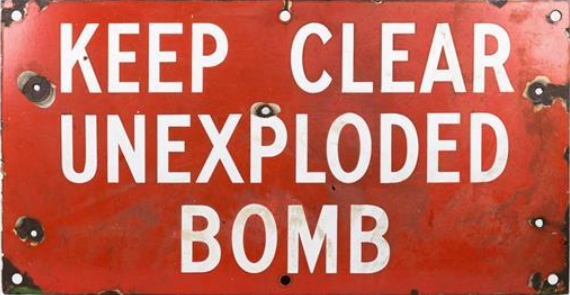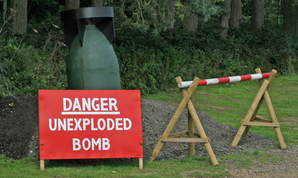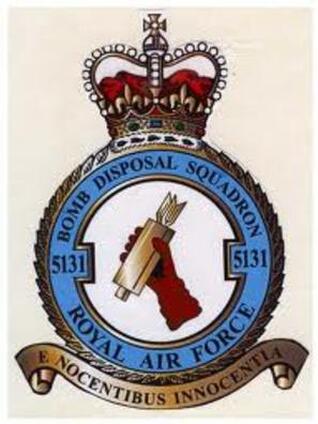|
The history of RAF Bomb Disposal started in 1939, when the real threat of having unexploded enemy bombs on British soil was realised. In the past, prior to 1939, the RAF along with the other armed forces was aware that not all the bombs dropped from the air would in fact explode.
Consequently, the responsibility for the disposal of any RAF unexploded bombs (UXB's) was the responsibility of the Senior Non Commissioned Armourers. It was therefore assumed that when war broke out in 1939, the disposal of enemy UXB's within RAF designated area would also be the responsibility of these same men. Arrangements were made to strengthen the BD Organisation and make clear the question of priority when dealing with UXO the different priorities (in order) are listed below
|
|
In 1940, there were 80 RAF Demolition Sections setup to carry out duties at the most important airfields across the UK which were called "X" (for explosive" Stations). The equipment available was primitive to say the least and there was minimal training given in addition to the normal training for Armament Tradesmen.
In September of the same year, the RAF Armament School had started five day bomb disposal courses to teach what was known about enemy bombs and bomb fuzes, |
|
By the summer of 1940 the Air Ministry realised that the "X" Squads were overtasked and stretched too far so a decision was made to disband the "X" Stations Squads in favour of official RAF Bomb Disposal Fights comprising of:
Each Flight was given a number and a name, and a designated area of responsibility and operated within its own area. The Demolition Sections had now become RAF Bomb Disposal or RAF BD Sections. They were also awarded the Bomb Disposal Trade badge |
On April 21 1943, the RAF Bomb Disposal Organisation was restructured into Squadrons and Flights. The personnel compliment of the flights was not changed from the previous organisation in 1940. On this occasion however, the Unit Commanding Officers and locations changed. The Squadrons were given a 4 figure number beginning with a 5 i.e. 5xxx Sqn RAF BD and the flights within the squadrons were given a 4 figure number beginning with a 6 i.e. 5xxx Flt RAF BD. The Squadrons were located as follows.
|
5130 Sqn RAF BD. Sqn Ldr E Bentley Commanding
6201 Flt Macmerry Scotland 6202 Macmerry Scotland 6203 Hollywood Belfast 6204 Dalcross Inverness 5131 Sqn RAF BD. Sqn Ldr HH Apted Commanding
6205 Flt Snaith Yorkshire 6206 Snaith Yorkshire 6207 Morpeth 6208 Sealand Chester 6209 Thornaby Yorkshire 5132 Sqn RAF BD. Sqn Ldr HT Kennar Commanding
6210 Flt Bramcote 6211 Bramcote 6212 Cardiff 6213 Cosford 6214 Digby 6315 Digby |
5133 Sqn RAF BD. Sqn Ldr AE Haarer Commanding
6126 Flt Waterbeach 6217 Waterbeach 6218 Feltwell 6219 Feltwell 6220 North Weald 6221 Hornchurch 5134 Sqn RAF BD. Sqn Ldr A Dykes Commanding
6222 Flt West Malling 6223 West Malling 6224 Hendon 6225 Kenley 5135 Sqn RAF BD. Sqn Ldr IH De Wynter Commanding
6226 Flt Harwell 6227 Middle Wallop 6228 Colerne 6229 Exeter |
D Day
The ability to support the Allied Forces on D Day was improved by the formation of 3 new Bomb Disposal Squadrons made up of Flights from the existing organisation. These were formed as follows:)
The ability to support the Allied Forces on D Day was improved by the formation of 3 new Bomb Disposal Squadrons made up of Flights from the existing organisation. These were formed as follows:)
|
5137 Sqn RAF BD. Sqn Ldr D Strachan Commanding
6220 Flt (from 5133) 6225 (from 5134) 5139 Sqn RAF BD. Sqn Ldr K Scammel Commanding
6205 Flt (from 5131) 6206 (from 5131) 6210 (from5132) |
5138 Sqn RAF BD. Sqn Ldr A Dykes Commanding (ex 5134)
6214 Flt (from 5132) 6228 (from 5135) 6337 specially formed for D Day |
The first BD Flight to embark for the beaches of Normandy was 6225 Flt commanded by Flt Lt Cartwright. On D Day +1 at 04.00 hours, 6225 Flt encountered ememy action when the landing craft they were in, No 390 was shelled by the German Shore Batteries and and E Boat at the port of Le Havre. The landing craft sank within two minutes. Seven men were killed, 6 hospitalised and one taken prisoner. In this incident, 90% of the equipment belonging to 6225 Flt was lost. The survivors were picked up by another landing craft and set ashore at MIKE/NAN beaches on June 8.
6225 Flight was initially non -operational, but by July 4 1944 having had personnel replaced and new equipment issued the Flight was able to make a successful landing on the Normandy beaches under their previous CO Flt Lt Cartwright.
On D Day + 2, 6220 Flight embarked for Gray-Sur Mer where the temporarily merged with the survivors of 6225 Flight.
As the Allied bridgehead strengthened and the Allied advances were being pushed home, more RAF BD Flights landed in Normandy with a formidable task ahead of them. The flights that went to Normandy after D Day cleared minefields and German bomb dumps (some were booby trapped) that had been left by the retreating German Forces.
On D Day + 2, 6220 Flight embarked for Gray-Sur Mer where the temporarily merged with the survivors of 6225 Flight.
As the Allied bridgehead strengthened and the Allied advances were being pushed home, more RAF BD Flights landed in Normandy with a formidable task ahead of them. The flights that went to Normandy after D Day cleared minefields and German bomb dumps (some were booby trapped) that had been left by the retreating German Forces.
At the end of the hostilities in Europe on May 8 1945, 90% of RAF BD Squadrons and Flights were employed in clearing and dismantling of German Air Force (GAF) weapons in Belgium, Denmark, Italy and Norway. By 1948. the Allied Air Forces own personnel who trained at the Bomb Disposal School in South Yorkshire were able to deal with their own GAF weaponry which resulted in the disbanding, one by one, of the original RAF BD Squadrons and Flights. The last disbandment was 5131 RAF BD Squadron at Snaith in 1948.
5131 was later resurrected and reorganised to become No's 1 & 2 Flights RAF BD based at Leconfield and Bicester.
They both later moved to RAF Wittering as the primary RAF BD School and operating unit. They are equipped with highly sophisticated equipment borne out of necessity in the hostile environments of places like the Falkland Islands, Northern Ireland, Former Yugoslavia, Afghanistan and Iraq wher the ever inventive terrorist plays a dangerous chess game with the lives of the EOD Operators.
5131 was later resurrected and reorganised to become No's 1 & 2 Flights RAF BD based at Leconfield and Bicester.
They both later moved to RAF Wittering as the primary RAF BD School and operating unit. They are equipped with highly sophisticated equipment borne out of necessity in the hostile environments of places like the Falkland Islands, Northern Ireland, Former Yugoslavia, Afghanistan and Iraq wher the ever inventive terrorist plays a dangerous chess game with the lives of the EOD Operators.
|
The RAF's Explosive Ordnance Disposal Squadron was set up in 1943 to defuse German bombs and by 1945 it had made safe 176,000 weapons.
It took part in the Falklands War in 1982, clearing the runway at Stanley, and was one of the first units over the Iraq border during Operation Granby in 1991. 5131 squadron has lived by its motto, to make the harmful harmless, in its operational role and the countless occasions in which it has assisted the civilian authorities to maintain public safety and has served this country with bravery, honour and distinction, maintaining the best traditions of the Royal Air Force throughout its history." |







